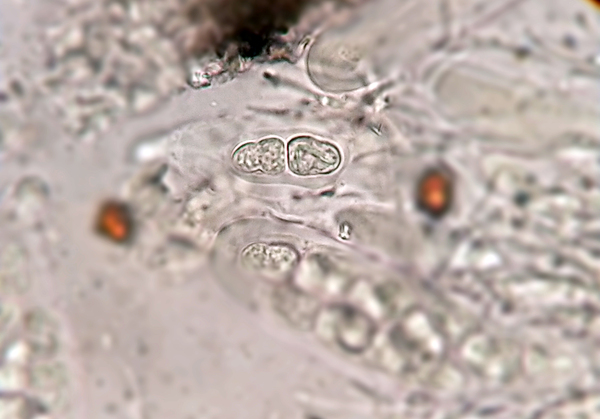Alloarthopyrenia italica Phukhams., Camporesi, Ariyaw. & K.D. Hyde
in Hyde & al., Fungal Diversity, 80: 135, 2016
Synonyms: Arthopyrenia cinereopruinosa auct. non (Schaer.) A. Massal.
Description: Thallus crustose, inconspicuous or slightly bleaching the bark, whitish grey, non-lichenized, without a prothallus. Perithecia black, circular or ellipsoid in outline, (0.2-)0.3-0.45 x 0.2-0.3(-0.4) mm, when young often covered by a thin layer of bark cells which gives them a grey-pruinose appearance. Involucrellum dimidiate, dark brown in water, K + greenish, clypeate, of compacted hyphae and bark cells; ostiole distinct, centrally located, filled with downwardly projecting periphyses: exciple 40-70 μm thick, pale brown; pseudoparaphyses stout, 1-1.5 μm thick, branched and anastomosing, the cells 8-16 μm long, often with elongate, oily vacuoles. Asci 8-spored, obovoid to suboblong, bitunicate, the tholus thickened, the ocular chamber up to 2-3 μm, apically rounded, 55-65 x 13-20 μm. Ascospores 1-septate, much constricted at septum, with somehow unequal cells, each cell with an obvious median constriction, hyaline, clavate to obovoid, with rounded apices, (14.5-)18-22(-24) x (5-)8-12 μm, with a 1-3 μm thick (in K), distinct perispore, the upper cell wider than the lower cell. Photobiont absent. Spot tests: all negative. Chemistry: without lichen substances.
Growth form: Fungus
Substrata: bark
Reproductive strategy: mainly sexual
Most common in areas with a humid-warm climate (e.g. most of Tyrrenian Italy)
Pioneer species
Commonnes-rarity: (info)
Alpine belt: absent
Subalpine belt: absent
Montane belt: extremely rare
Dry submediterranean belt: very rare
Humid submediterranean belt: rare
Padanian area: extremely rare
pH of the substrata:
1 2 3 4 5
Solar irradiation:
1 2 3 4 5
Aridity:
1 2 3 4 5
Eutrophication:
1 2 3 4 5
Poleotolerance:
0 1 2 3
Altitudinal distribution:
1 2 3 4 5 6
Rarity
absent
extremely rare
very rare
rare
rather rare
rather common
common
very common
extremely common
Loading data...
Occurrence data
Predictive map

Source: Keissler K. von 1938. Pyrenulaceae, Mycoporaceae, Coniocarpineae. In: Rabenhorst G L: Kryptogamen-Flora von Deutschland, Österreich und der Schweiz. 2nd, IX, Die Flechten, Abt. 1, 2. Gebr. Borntraeger, Leipzig, pp. 1-846.

Photo uploaded by P. Cannon - CC BY-SA NC - Source: http://fungi.myspecies.info/all-fungi/arthopyrenia-cinereopruinosa
Growth form: Fungus
Substrata: bark
Reproductive strategy: mainly sexual
Most common in areas with a humid-warm climate (e.g. most of Tyrrenian Italy)
Pioneer species
Commonnes-rarity: (info)
Alpine belt: absent
Subalpine belt: absent
Montane belt: extremely rare
Dry submediterranean belt: very rare
Humid submediterranean belt: rare
Padanian area: extremely rare
pH of the substrata:
| 1 | 2 | 3 | 4 | 5 |
Solar irradiation:
| 1 | 2 | 3 | 4 | 5 |
Aridity:
| 1 | 2 | 3 | 4 | 5 |
Eutrophication:
| 1 | 2 | 3 | 4 | 5 |
Poleotolerance:
| 0 | 1 | 2 | 3 |
Altitudinal distribution:
| 1 | 2 | 3 | 4 | 5 | 6 |
Rarity
absent
extremely rare
very rare
rare
rather rare
rather common
common
very common
extremely common
Loading data...
Occurrence data
Predictive map

Source: Keissler K. von 1938. Pyrenulaceae, Mycoporaceae, Coniocarpineae. In: Rabenhorst G L: Kryptogamen-Flora von Deutschland, Österreich und der Schweiz. 2nd, IX, Die Flechten, Abt. 1, 2. Gebr. Borntraeger, Leipzig, pp. 1-846.
























